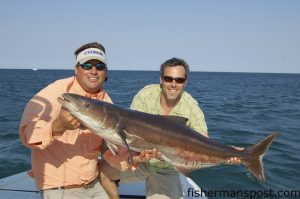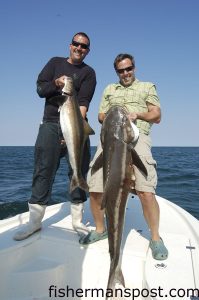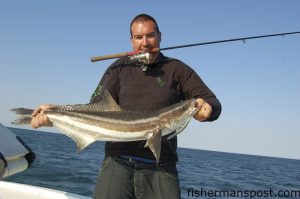Cobia From The Crow’s Nest

Capt. Mike Taylor, of Taylor-Made Charters, and Gary Hurley with a 40 lb. class cobia that fell for a sight-cast bucktail jig with a Gulp eel trailer just a few hundred yards off the beach at Cape Lookout.
On rare occasion, it can be better when a game plan doesn’t work out than when it does. For the past few weeks, Gary Hurley and I had been looking forward to an offshore flounder trip with Capt. Mike Taylor, who operates Taylor-Made Charters out of Swansboro. When he called Gary the evening before our scheduled trip, he’d shaken up the plan a bit.
“The cobia showed up at Cape Lookout today, so I’m going cobia fishing tomorrow,” Taylor told us. “You guys are welcome to come if you want.”
We certainly enjoy flounder fishing, but this was no invitation to turn down, and 3:30 the next morning found us headed up the road in Gary’s Honda Passport, the peculiar combination of grogginess and excitement that only fishermen know fueling the drive as much as the gas did.
Gary had never caught a keeper cobia before, and I’d never caught one in North Carolina, so Mike’s insistence on cobia fishing had us near-quaking with anticipation as we hurried to meet him at the Taylor’s Creek boat ramp in Beaufort.
As they generally do in the calm pre-dawn hours, the trip went smoothly, and we were soon idling east toward the Cape as Mike explained the new game plan.
“We’re going to look for some menhaden by Harker’s Island and live-bait them,” Mike explained as he readied a cast net and scanned the water’s surface for the telltale flipping menhaden.
A brief search revealed no flips, and we were soon scooting past the Lookout Lighthouse and out Barden’s Inlet.
“A live bluefish is a great cobia bait,” Mike explained as he slowed the boat to trolling speed and produced a pair of Yo-Zuri Deep Divers. “It’s like a Snicker’s bar to a big one. We’re going to troll a few up and then go fishing.”
We’d been bumping along around 1/2 a mile off Shackleford Banks for approximately five minutes when one of the 10 lb. class trout rods we were trolling with dipped over hard and the reel’s drag began to shriek.
“That’s either a pretty powerful bluefish, or Mike is fishing some mighty light drags,” I thought to myself as I pulled the spinner from a gunnel holder. Mike told us the chopper blues (8-10+ lbs.) move in about the same time the cobes do every spring, so the thought that I was in battle with a big blue was cool, but we were after bait, so I wanted to make it quick.
“That’s probably one of those big Hatteras bluefish,” Mike said, adding with a chuckle, “but you might have hung a cobia.”
The fish’s first run seemed ceaseless, and as metal became visible on the 3000 Stradic’s spool, Mike spun the boat around and gave my unseen opponent chase.
As I gained back a bit of the line lost, I began to feel a little more comfortable. We closed in on the fish steadily, and as it took a turn forcing me to follow it from the bow down the port gunnel, I heard Mike get excited for the first time that morning.
“It’s a cobia!” he blurted out. “Look!”
I followed his outstretched finger and saw the unmistakable brown and white sides of a cobia appear on the surface a few waves towards the beach from us.
The long first run seemed to have done little to tire the fish and, as though it didn’t like being pointed at, the fish took off again, this time heading down in the water.
I tried to slow the fish, but with 10 lb. tackle, there’s only so much pressure you can exert, and I’m sorry to report it was another 10 minutes of working the fish to the surface only to have it sound again and again before I was able to lead it into Mike’s waiting landing net.
After netting the fish, he broke out a measuring board, but even before we measured it, Mike made clear why this fish had gotten the net treatment instead of the gaff.
“We’re going to let him go even if he is legal,” the captain said as we disentangled the fish and treble-hooked plug from the mesh. “I’m getting the feeling we’ll be seeing more of them today.”
The numbers didn’t lie, and my fish proved 1/2” shy of the 33” fork length minimum size limit, but I was still thrilled that we’d caught and released a cobia within 20 minutes of pushing out the inlet.
I suspect Mike may have already grown tired of listening to Gary and my (admittedly bad) jokes about “having” to go cobia fishing instead of floundering, but landing a cobe while we were still trying to catch some bait only ratcheted up the poor attempts at humor.
With the Deep Divers re-set behind the boat, Mike turned us toward the Cape, and it wasn’t long before a pair of bluefish and a spanish mackerel were in the boat circling our livewell and nursing treble hook wounds.
Mike was planning to anchor up near the inlet and fish baits on the bottom after we’d caught our blues but, as already noted, this was a day full of game-changers.
As we got closer to the Cape, a beautiful drop off a few hundred feet from shore caught our eyes, and Mike grabbed a heavy spinning rod rigged with a 2 oz. bucktail and walked to the bow.
“Gary, you steer us right along that drop,” Mike instructed as he threaded a Gulp eel onto the bucktail’s hook. “I’m going to see if we can see any to sight-cast to.”
These words definitely got my blood pumping, and I grabbed a twin of Mike’s heavy spinning rod and began scanning the water from the back casting deck. When my concentration broke after a few minutes, I looked back towards the bow, and became mildly concerned with the fact that the captain no longer appeared to be in the boat.
I think Gary saw my double take before I got the words out, and he just grinned and pointed to the sky.
Mike was perched atop the boat’s T-top, spinner in hand, clearly focused on the hunt. A bit later, curiosity got the best of Gary and he asked, “Can you just stand anywhere up there, or do you have to keep your feet on one spot?”
Mike replied with a chuckle, “One spot, and it’s little.”
Though it wasn’t rough, his balancing act was nonetheless impressive.
Just then, one of the trolling rods began shrieking again, and this clearly wasn’t another bluefish or spaniard. We traded places as Gary took the rod from the holder and I took the helm.
After a blistering run, the fish surfaced, and Mike saw it first.
“Another cobia, and it’s a nice one,” he informed us, climbing down from his makeshift crow’s nest.
I soon got my own look at the fish, and indeed it was far more substantial than mine had been. I also noticed Mike held the gaff instead of the net for Gary’s fish.
Assuming it would be a lengthy battle, I began heckling the boss about playing around with his fish on the light gear. My words only served to make me look the fool when Mike planted the gaff in the fish less than five minutes into the battle and swung it aboard.
“He’ll go 25 or 30 lbs.,” the captain estimated while we hurriedly reset the lines, adding with a grin, “Maybe we should just troll Deep Divers all day.”

The author and Gary Hurley with a mismatched pair of cobia--a 15 lb. fish that bit a bucktail/Gulp Eel combo and a 75 lb. brute that crushed a Berkely Powerbait Eel. Both fish were part of a pod of 4-6 fish crusing down the edge of a drop-off just off the beach at Cape Lookout.
After a few photos, the fish hit the box, and we continued along the drop-off, working ever closer to the rock jetty protruding from the beach east of the inlet.
I grabbed the heavy spinner again, and took the bow deck while Mike again went up top, and we’d been moving no more than five minutes when he told Gary to back off the throttle.
“Idle, Gary, there they are,” he said, pointing with his rod. I struggled to follow the vector, but couldn’t see the fish until Mike made a cast. A group of indistinct brown shapes was visible moving casually along the bottom until one of them darted towards Mike’s jig.
My cast had landed behind the fish, and Mike set the hook as I hurriedly reeled in and tried to make another cast.
The fish had disappeared (at least to my eyes), but Mike was handing down the doubled-over spinner to Gary, and I was beginning to have a feeling I’d get a few more chances before the day was out.
Mike’s casting rods bear heavier braid than the trout rods we’d landed our previous fish on, and Gary was able to use the stouter gear to put some heat on the fish, but this one had a little more will than his first. A fleeting opportunity to put it in the boat passed as it rolled near the gunnel before taking yet another deep run.
“You usually get that one early shot at them,” Mike explained as we both watched Gary try to muscle the fish back up while keeping an eye out for more fish nearby. “If you don’t get them then, it’s going to be a decent fight.”
After a series of appearances just out of outstretched gaff range followed by more runs to the bottom and enough direction changes to make Gary circle the boat a time and a half, it was game over: a cobia, and our second keeper fish of the day, hit the deck.
“That one’s 35 or 40,” Mike said as we waited for the fish to calm down enough for a photo opportunity. This was another fish for the box, and with our second cobe on ice, we continued prospecting up the drop-off.
We landed several more legal fish that were netted and released (out of at least a dozen fish we saw) by the time the rock jetty cut off our path.
“Let’s motor back up there and come down this drop-off again,” Mike said, hopping down from T-top and taking over the controls. “We could just go back this way, but with the sun angle, it’s a lot easier to see them moving like we were.”
As we motored towards Barden’s Inlet to set up another pass, I couldn’t help notice that three of the other boats in the area seemed to have taken note of our success and were miming what we’d done, slowly motoring down the edge of the drop and looking for fish.
The crowd only grew after our next pass.
Within a few minutes of turning back toward the jetty, Mike spied a large pod of cobia, these fish cruising on top instead of along the bottom, and two quick casts put Gary and I fast to a double header hookup.
My fish was a legal cobe about 15 lbs., and with the heavier tackle, I was able to get it to the boat in time for Mike to take an early shot with the landing net. The words that came out of my mouth when I got a look at Gary’s adversary aren’t fit for print, but after I calmed down a bit I found myself repeatedly muttering, “My God, that’s a lot of fish.”

Max Gaspeny with an unexpected surprise when trying to catch a bluefish for bait--a 32"cobia that fell for a Yo-Zuri Deep Diver and put up a 15 minute fight on a 10 lb. class trout rod.
The cobia Gary was battling looked like an oak trunk with pectoral fins compared to the sapling I’d just put in the boat.
I continued involuntarily chanting while the fight waged on, noticing that each diving run seemed to be a bit shorter than the last, hopefully a sign that the cranked down drag on the 65 lb. braid was taking a toll on the fish.
Apparently it was, as Mike proved once and for all a few moments later when he stretched way out with the gaff and put the 70+ lb. fish in the boat.
At least 70+ is what he called it, and since he’s caught a few more cobia than I, I decided to take him at his word despite the fact that I’d have sworn it was a hundred.
“Berkley 12” Powerbait eel,” I heard Mike say, and it was my first notice that he’d switched up one rod from the bucktail to a footlong black soft-plastic eel rigged with a pair of hooks and an internal weight. Good enough for a 70 pounder is good enough for me, and I resolved to tie one on myself after we dealt with the fish on the deck.
Clearly I (at 6’8”) with a small fish and Gary (at 6’) with a monster was a necessary photo op. After the beast calmed down, Gary struggled to heft his prize for the photo (while vehemently maintaining that it should be easier to lift as he’s been spending time in the gym).
Fish so big they’re challenging to hold up for photos are the reason we fish, and it was Gary’s turn to ramble some words of nonsensical exuberance.
While we physically and verbally high-fived the double header and the giant in the boat, I revived my fish by holding it in the current until it clamped down on my thumb and took off with a strong tail kick.
We barely resumed our course toward the rocks when a pod of four fish appeared off the port bow. As they grew closer, it became apparent that the alpha in this pack was even larger than Gary’s fish, and Mike and I cast at nearly the same time. The monster charged Mike’s eel, and the bucktail I’d forgotten to change out appealed to the smallest fish in the group, a tiny one that couldn’t have weighed five pounds and looked like a remora next to the big cobe. Apparently it was too small to eat my jig, though it tried, and the giant apparently wasn’t too hungry, as it investigated Mike’s eel and then slowly swam off.
The huge fish had gotten even Mike, generally a pretty calm guy, excited. He rigged up a live bluefish pitch bait for the next beast that wouldn’t take an artificial.
I switched over to the Powerbait eel while Mike rigged the blue and Gary kept us on course, all of us keenly searching for our next targets at the same time.
As we closed in on the jetty, we saw six fish swimming parallel to it in a perfect line, and a pair of decent casts earned Gary and I our second double hookup. This time mine was the larger fish, nowhere near Gary’s trophy, but a solid 40 pounder that met the gaff.
Longtime readers are no doubt familiar with the work, school, and family obligations that often force us to cut trips short, and sadly, Gary had an unbreakable one this day—Cape Fear Community College Graduation. We made another pass down the beach, catching several more fish and adding one to the box, before Gary reluctantly made the call.
“Mike, I’ve got to be back on the road by 12:30,” he sadly related, “and if it were for just about anything else, we’d be here casting at cobia till sunset with you, but graduation is a work obligation I can’t miss.”
We’d kept our five biggest fish and easily released that many more legal fish, so it wasn’t too bittersweet to have to call it a day.
“Well, I’m going to drop you boys off, get some gas and get back out there,” Mike said, clearly still intent on that giant fish that checked out his bait.
We got on the road with just enough time for Gary to make it home and to school, and Mike did fire a parting shot, calling us as we rolled through Jacksonville to let us know he’d already caught four more, including a 50 pounder.
My lesson for the day was the following: if Capt. Mike Taylor changes the game plan, grin and hold on for the ride.
In addition to sight-casting and blind-fishing for cobia, Mike pursues redfish, trout, and flounder inshore, as well as king mackerel, amberjacks, flounder, and more at the wrecks and rocks off Bogue Inlet.
To talk to Mike about booking a charter or just to get more information, give him a call at (252) 725-2623 or visit www.nccharterfishing.com.





